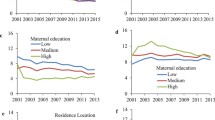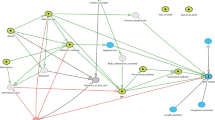Abstract
Objectives
To examine the socioeconomic gradients in birth outcomes among singleton infants in Argentina, 2003–2007.
Methods
We analyzed data of 3,230,031 singleton infants born in 2003–2007, obtained from vital statistics. Associations between birth outcomes [small for gestational age (SGA), low birth weight (LBW), and preterm birth (PTB)] and socioeconomic indicators (maternal education and area-based material deprivation quintiles) were assessed with logistic regression.
Results
The risk of SGA increased with higher socioeconomic disadvantage, but that of PTB decreased. Compared to mothers who attained a tertiary or university degree, mothers who did not complete primary school were more likely to have a SGA infant [adjusted OR (95 % CI): 1.65 (1.62, 1.68)], but less likely to deliver preterm [0.92 (0.90, 0.94)]. As a result of the conflicting trends in SGA and PTB, LBW exhibited inconsistent socioeconomic gradients.
Conclusions
The excess risk of adverse birth outcomes associated with socioeconomic disadvantage was consistently reflected by SGA, but not by LBW and PTB. These findings challenge the usefulness of LBW as an indicator population health. Further research is needed to explain the reverse socioeconomic gradients in PTB.


Similar content being viewed by others
References
Basso O, Wilcox AJ, Weinberg CR (2006) Birth weight and mortality: causality or confounding? Am J Epidemiol 164(4):303–311
Belizan JM, Althabe F, Barros FC, Alexander S (1999) Rates and implications of caesarean sections in Latin America: ecological study. BMJ 319(7222):1397–1400
Canadian Institute for Health Information (2009) Too early, too small: a profile of small babies across Canada. CIHI, Ottawa
Casale RA (2009) Socioeconomic levels and cesarean rates. Inequity in health care access? An ecologic study. Revista de Obstetricia y Ginecologia de Buenos Aires 88(982):200–211
Demissie K, Hanley JA, Menzies D, Joseph L, Ernst P (2000) Agreement in measuring socio-economic status: area-based versus individual measures. Chronic Dis Can 21(1):1–7
Frank JW, Haw S (2011) Best practice guidelines for monitoring socioeconomic inequalities in health status: lessons from Scotland. Milbank Q 89(4):658–693
Joseph KS, Demissie K, Kramer MS (2002) Obstetric intervention, stillbirth, and preterm birth. Semin Perinatol 26(4):250–259
Joseph KS, Young DC, Dodds L, O’Connell CM, Allen VM, Chandra S, Allen AC (2003) Changes in maternal characteristics and obstetric practice and recent increases in primary cesarean delivery. Obstet Gynecol 102(4):791–800
Kaufman JS, Alonso FT, Pino P (2008) Multi-level modeling of social factors and preterm delivery in Santiago de Chile. BMC Pregnancy Childbirth 8:46
Klebanoff MA, Keim SA (2011) Epidemiology: the changing face of preterm birth. Clin Perinatol 38(3):339–350
Ministry of Health (2001) Forms and Instructions of the Vital Statistics System. Ministerio de Salud de la Nación, Dirección de Estadística e Información de Salud, Programa Nacional de Estadísticas de Salud, Buenos Aires
Murray SF (2000) Relation between private health insurance and high rates of caesarean section in Chile: qualitative and quantitative study. BMJ 321(7275):1501–1505
NationaI Institute of Statistics and Censuses (2004) The study of poverty in the 2001 National Census of Population, Households and Dwellings. Methodology of the development of the Household Material Deprivation Index. INDEC, Buenos Aires
Observatory of Maternity Foundation (2001) Deliveries by mode and type of institution according to per capita household income quintiles and poverty status. Fundación Observatorio de la Maternidad
Public Health Agency of Canada (2008) Canadian Perinatal Health Report, 2008th edn. Public Health Agency of Canada, Ottawa
Schieve LA, Ferre C, Peterson HB, Macaluso M, Reynolds MA, Wright VC (2004) Perinatal outcome among singleton infants conceived through assisted reproductive technology in the United States. Obstet Gynecol 103(6):1144–1153
Solis P, Pullum SG, Frisbie P (2000) Demographic models of birth outcomes and infant mortality: an alternative measurement approach. Demography 37(4):489–498
United Nations Children’s Fund and World Health Organization (2004) Low birthweight: country, regional and global estimates. UNICEF, New York
Urquia ML, Alazraqui M, Spinelli HG, Frank JW (2011) Reference birthweights for the Argentine population by multiplicity of birth, sex, and gestational age. Rev Panam Salud Publica 29(2):108–119
Urquia ML, Moineddin R, Frank JW (2012) A mixture model to correct misclassification of gestational age. Ann Epidemiol 22(3):151–159
Villar J, Valladares E, Wojdyla D, Zavaleta N, Carroli G, Velazco A, Shah A, Campodonico L, Bataglia V, Faundes A, Langer A, Narvaez A, Donner A, Romero M, Reynoso S, de Padua KS, Giordano D, Kublickas M, Acosta A (2006) Caesarean delivery rates and pregnancy outcomes: the 2005 WHO global survey on maternal and perinatal health in Latin America. Lancet 367(9525):1819–1829
Villar J, Carroli G, Zavaleta N, Donner A, Wojdyla D, Faundes A, Velazco A, Bataglia V, Langer A, Narvaez A, Valladares E, Shah A, Campodonico L, Romero M, Reynoso S, de Padua KS, Giordano D, Kublickas M, Acosta A (2007) Maternal and neonatal individual risks and benefits associated with caesarean delivery: multicentre prospective study. BMJ 335(7628):1025
Wilcox AJ (2001) On the importance—and the unimportance—of birthweight. Int J Epidemiol 30(6):1233–1241
Wisborg K, Ingerslev HJ, Henriksen TB (2010) IVF and stillbirth: a prospective follow-up study. Hum Reprod 25(5):1312–1316
Author information
Authors and Affiliations
Corresponding author
Rights and permissions
About this article
Cite this article
Urquia, M.L., Frank, J.W., Alazraqui, M. et al. Contrasting socioeconomic gradients in small for gestational age and preterm birth in Argentina, 2003–2007. Int J Public Health 58, 529–536 (2013). https://doi.org/10.1007/s00038-012-0440-3
Received:
Revised:
Accepted:
Published:
Issue Date:
DOI: https://doi.org/10.1007/s00038-012-0440-3




